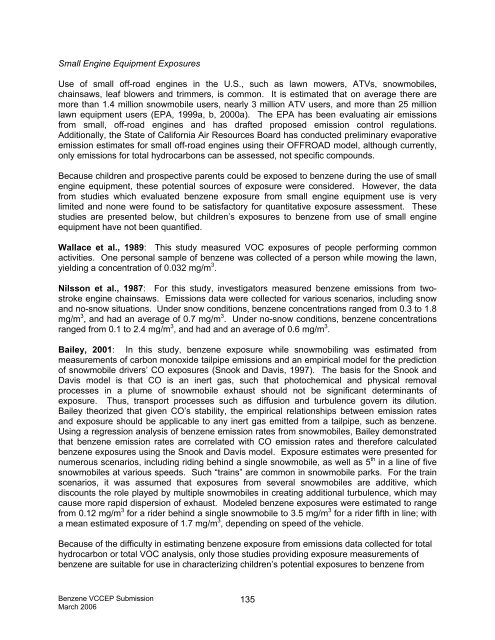(VCCEP) Tier 1 Pilot Submission for BENZENE - Tera
(VCCEP) Tier 1 Pilot Submission for BENZENE - Tera
(VCCEP) Tier 1 Pilot Submission for BENZENE - Tera
Create successful ePaper yourself
Turn your PDF publications into a flip-book with our unique Google optimized e-Paper software.
Small Engine Equipment Exposures<br />
Use of small off-road engines in the U.S., such as lawn mowers, ATVs, snowmobiles,<br />
chainsaws, leaf blowers and trimmers, is common. It is estimated that on average there are<br />
more than 1.4 million snowmobile users, nearly 3 million ATV users, and more than 25 million<br />
lawn equipment users (EPA, 1999a, b, 2000a). The EPA has been evaluating air emissions<br />
from small, off-road engines and has drafted proposed emission control regulations.<br />
Additionally, the State of Cali<strong>for</strong>nia Air Resources Board has conducted preliminary evaporative<br />
emission estimates <strong>for</strong> small off-road engines using their OFFROAD model, although currently,<br />
only emissions <strong>for</strong> total hydrocarbons can be assessed, not specific compounds.<br />
Because children and prospective parents could be exposed to benzene during the use of small<br />
engine equipment, these potential sources of exposure were considered. However, the data<br />
from studies which evaluated benzene exposure from small engine equipment use is very<br />
limited and none were found to be satisfactory <strong>for</strong> quantitative exposure assessment. These<br />
studies are presented below, but children’s exposures to benzene from use of small engine<br />
equipment have not been quantified.<br />
Wallace et al., 1989: This study measured VOC exposures of people per<strong>for</strong>ming common<br />
activities. One personal sample of benzene was collected of a person while mowing the lawn,<br />
yielding a concentration of 0.032 mg/m 3 .<br />
Nilsson et al., 1987: For this study, investigators measured benzene emissions from twostroke<br />
engine chainsaws. Emissions data were collected <strong>for</strong> various scenarios, including snow<br />
and no-snow situations. Under snow conditions, benzene concentrations ranged from 0.3 to 1.8<br />
mg/m 3 , and had an average of 0.7 mg/m 3 . Under no-snow conditions, benzene concentrations<br />
ranged from 0.1 to 2.4 mg/m 3 , and had and an average of 0.6 mg/m 3 .<br />
Bailey, 2001: In this study, benzene exposure while snowmobiling was estimated from<br />
measurements of carbon monoxide tailpipe emissions and an empirical model <strong>for</strong> the prediction<br />
of snowmobile drivers’ CO exposures (Snook and Davis, 1997). The basis <strong>for</strong> the Snook and<br />
Davis model is that CO is an inert gas, such that photochemical and physical removal<br />
processes in a plume of snowmobile exhaust should not be significant determinants of<br />
exposure. Thus, transport processes such as diffusion and turbulence govern its dilution.<br />
Bailey theorized that given CO’s stability, the empirical relationships between emission rates<br />
and exposure should be applicable to any inert gas emitted from a tailpipe, such as benzene.<br />
Using a regression analysis of benzene emission rates from snowmobiles, Bailey demonstrated<br />
that benzene emission rates are correlated with CO emission rates and there<strong>for</strong>e calculated<br />
benzene exposures using the Snook and Davis model. Exposure estimates were presented <strong>for</strong><br />
numerous scenarios, including riding behind a single snowmobile, as well as 5 th in a line of five<br />
snowmobiles at various speeds. Such “trains” are common in snowmobile parks. For the train<br />
scenarios, it was assumed that exposures from several snowmobiles are additive, which<br />
discounts the role played by multiple snowmobiles in creating additional turbulence, which may<br />
cause more rapid dispersion of exhaust. Modeled benzene exposures were estimated to range<br />
from 0.12 mg/m 3 <strong>for</strong> a rider behind a single snowmobile to 3.5 mg/m 3 <strong>for</strong> a rider fifth in line; with<br />
a mean estimated exposure of 1.7 mg/m 3 , depending on speed of the vehicle.<br />
Because of the difficulty in estimating benzene exposure from emissions data collected <strong>for</strong> total<br />
hydrocarbon or total VOC analysis, only those studies providing exposure measurements of<br />
benzene are suitable <strong>for</strong> use in characterizing children’s potential exposures to benzene from<br />
Benzene <strong>VCCEP</strong> <strong>Submission</strong><br />
March 2006<br />
135





